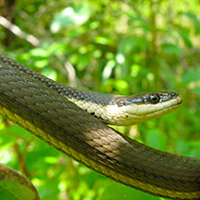Queensnake
Scientific name: Regina septemvittata

Cover photo credit: Rob Tervo
Status
Endangered
"Endangered" means the species lives in the wild in Ontario but is facing imminent extinction or extirpation.
Date added to the Species at Risk in Ontario List
The Queensnake was listed as threatened when the Endangered Species Act took effect in 2008.
It was reassessed as endangered on September 28, 2010.
Read the assessment report.
What it looks like
The Queensnake is a non-venomous, slender snake that can reach up to 60 centimetres in length. It lives in streams and rivers with good water quality where it can hunt for crayfish, its main food source. The body is brownish olive above with three dark stripes running down the back. The belly is pale yellow with four dark stripes running along its length. This species can be easily identified as it is the only snake in Ontario with a longitudinally striped belly.
Where it lives
The Queensnake is an aquatic species that is seldom found more than a few metres from the water. It prefers rivers, streams and lakes with clear water, rocky or gravel bottoms, lots of places to hide, and an abundance of crayfish. Queensnakes will often hibernate in groups with other snakes, amphibians and even crayfish. Suitable hibernation sites (called hibernacula) include abutments of old bridges and crevices in bedrock.
Where it’s been found in Ontario
In Ontario, the Queensnake is found only in the southwest in Middlesex, Brant, Huron and Essex counties, and on the Bruce Peninsula. There are fewer than 25 sites where it is known to occur in these areas.
The extremely specialized habitat requirements of the Queensnake restrict this species to particular areas, with large gaps of unfavourable habitat in between populations. The snake’s home range is quite small, making Queensnakes less likely to move into new areas or areas where it was historically found.
View a larger version of this map (PDF)
What threatens it
The most significant threat to the Queensnake is habitat loss due to drainage or disturbance of waterways, urban development along shorelines, and pollution. As a result of waterway pollution, crayfish, which require good water quality, have died out and Queensnake numbers have declined. Trampling by walking and standing on shoreline rocks has contributed to the deaths of some Queensnakes. Human persecution and illegal collection for the pet trade are also concerns.
Action we are taking
Threatened species and their general habitat are automatically protected.
Recovery strategy
A recovery strategy advises the ministry on ways to ensure healthy numbers of the species return to Ontario.
Read the executive summary and full document (February 18, 2011).
Government response statement
A government response statement outlines the actions the government intends to take or support to help recover the species.
Read the government response statement (November 18, 2011).
Five-Year Review of Progress
A five-year review reports on progress made toward protecting and recovering a species, within five years of publishing a species’ government response statement.
Read the report on progress towards the protection and recovery of 27 species at risk, including Queensnake (2016).
Habitat protection
A habitat regulation defines a species’ habitat and may describe features (e.g., a creek, cliff, or beach), geographic boundaries or other unique characteristics.
Read the habitat regulation summary (January 1, 2014).
What you can do
Report a sighting
- Report a sighting of an endangered animal or plant to the Natural Heritage Information Centre. Photographs with specific locations or mapping coordinates are always helpful.
- appreciate snakes and don’t harm them; sadly, people continue to deliberately kill snakes - keep the danger of snakes in perspective: All of Ontario’s snakes are non-venomous, except for the very rare Massasauga
- if you come across a snake, please don’t try to capture it, handle it or kill it; snakes can be delicate and improper handling can cause serious injury; also, certain species are protected under legislation, which makes it illegal to harass, harm or kill them; be respectful and observe from a distance
Volunteer
Volunteer with your local nature club or provincial park to participate in surveys or stewardship work focused on species at risk.
Be a good steward
- private land owners have a very important role to play in species recovery; you may be eligible for stewardship programs that support the protection and recovery of species at risk and their habitats
- every year, snakes all over the province must cross busy roads; watch for snakes on the road, especially between May and October when they are most active
- help to keep our waterways healthy; if you own riverfront property, maintain natural vegetation along the shoreline - the Queensnake and its food (crayfish) are very sensitive to pollution; ask for environmentally friendly fertilizer and alternatives at your gardening store
Report illegal activity
- report any illegal activity related to plants and wildlife to
1-877-TIP-SMNR (847-7667) - never buy snakes that have been caught in the wild and never buy a native species of any kind that’s being sold as a pet
Quick facts
- the Queensnake is not venomous, like all of Ontario’s snakes except for the Massasauga rattlesnake; the Queensnake is very shy and will always flee when threatened; they do not bite unless they are picked up, so there is no need to worry about sharing your backyard with the elegant Queensnake
- Queensnakes are excellent swimmers and can often be seen swimming and hunting underwater for their main food source – freshly-moulted crayfish; when freshly moulted, crayfish are soft, defenceless and easier to swallow – ironically, during winter hibernation, crayfish turn the table and will eat juvenile and hibernating Queensnakes
- although this snake is highly aquatic and a great swimmer, it can also climb trees; you may be lucky enough to see one of these elegant snakes resting and basking in the branches of a small tree or shrub on the shoreline
